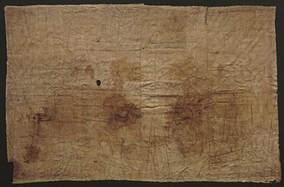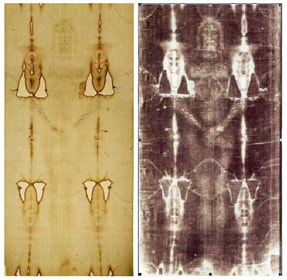
First let us evaluate information about the Sudarium, translation means a sweat cloth, one was used to cover Jesus' face before He was removed from the cross and buried. This meets Jewish tradition that the life blood of a person must be saved and buried with that person. This face cloth held that blood and bodily fluids. Men having a Sudarium cloth, about two feet squared, always tied around their neck, was common. This cloth facilitated the wiping of sweat from one's face in the hot climate. The Sudarium, now kept in Spain, has 120 points of contact and patterns that match the Shroud with computer accuracy. The Sudarium dates back to Jerusalem for the year 616 AD by written documents. Additional information brings the Sudarium back to 400 AD Jerusalem. There is no image on the Sudarium because the cloth would have been removed when Jesus was placed on his Sindone, aka Shroud or burial cloth. Perhaps John used his own Sudarium that was around his neck to cover Jesus’ face. He was the youngest and the only apostle at the foot of the cross. Both clothes were found in the tomb on Easter morning as written in John's Gospel.
Just one of several studies done is from the frozen lake bed at the top of Mount Kenya. Quoting the original ScienceDaily article, “A sudden warming of climate lasting several centuries took place in equatorial Africa some 2,000 years ago, according to a new study reported by a Weizmann Institute of Science-led team in the August 14 issue of Science.”
Research scientists performed isotopic analysis of the sediments from Hausberg Tarn, a small lake at an altitude of 4,350 meters on a slope of Mt. Kenya. The top of Mt. Kenya is at 4,600-4,700 meters and is covered by permanent glaciers. Scientists found that a rapid and significant warming of lake water, around 4 degrees Celsius, took place between the years 350 BC and 450 AD, reflecting a warming of climate that probably allowed the Roman Empire to conquer as far north as Scotland.
To have all the facts is always critical and code red to know the complete picture. From the Weizmann Institute report and others, we know for the time period stated above, temperatures were about 4 degrees celsius above our pre-industrial era temperatures. Currently, we are 1.5 degrees celsius above. So 2,000 years ago a rough estimate would put midday temperatures in Jerusalem during the month of April around 93 degrees Fahrenheit. Additionally, there is environmental data from the Dead Sea's soil excavation that backs up the actual date of the first Good Friday, the earthquakes, and how the day grew dark at noon. There was no solar eclipse that afternoon, but there was a dust storm kicked up by the earthquakes. Upon moon rise that evening, NASA data shows there was a blood red moon rising on Jerusalem due to a lunar eclipse. These events are cited and recorded and only one date meets all the prerequisites: April 3, 33 AD
One more point... There are dozens of facts showing the Shroud is 2,000 years old and the 1988 Carbon 14 tests done on the Shroud of Turin, outside of all proper scientific protocol, have been retracted and are no longer valid. Jesus did one last miracle 2,000 years ago for us today with our technology. He gave us a full front and back photograph of Himself to show that he understands life on earth, the joy and the suffering — the worst kind of suffering. He is with us, He is on our team — humankind, and because of Him, there is existence beyond this earth.
Happy Easter and Peace Be with Us All,
Bill Lauto, at GoingTrueGreen.com
Environmental Scientist
International Sustainability and Energy Consultant
Contribute your comments!
























